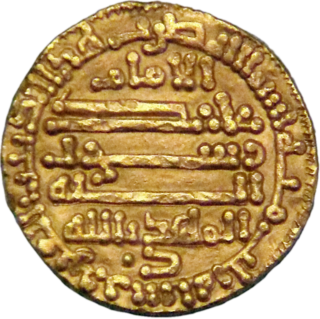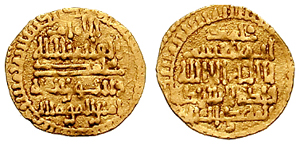The 900s decade ran from January 1, 900, to December 31, 909.
The 910s decade ran from January 1, 910, to December 31, 919.
The 920s decade ran from January 1, 920, to December 31, 929.
The 960s decade ran from January 1, 960, to December 31, 969.
The 970s decade ran from January 1, 970, to December 31, 979.

Year 946 (CMXLVI) was a common year starting on Thursday of the Julian calendar.

Year 902 (CMII) was a common year starting on Friday of the Julian calendar.
Year 893 (DCCCXCIII) was a common year starting on Monday of the Julian calendar.

The Fatimid Caliphate, also known as the Fatimid Empire, was a caliphate extant from the tenth to the twelfth centuries CE under the rule of the Fatimids, an Isma'ili Shia dynasty. Spanning a large area of North Africa and West Asia, it ranged from the western Mediterranean in the west to the Red Sea in the east. The Fatimids trace their ancestry to the Islamic prophet Muhammad's daughter Fatima and her husband Ali, the first Shia imam. The Fatimids were acknowledged as the rightful imams by different Isma'ili communities as well as by denominations in many other Muslim lands and adjacent regions. Originating during the Abbasid Caliphate, the Fatimids initially conquered Ifriqiya. They extended their rule across the Mediterranean coast and ultimately made Egypt the center of the caliphate. At its height, the caliphate included—in addition to Egypt—varying areas of the Maghreb, Sicily, the Levant, and the Hejaz.
The Fatimid dynasty was an Arab dynasty that ruled the Fatimid Caliphate, between 909 and 1171 CE. Descended from Fatima and Ali, and adhering to Isma'ili Shi'ism, they held the Isma'ili imamate, and were regarded as the rightful leaders of the Muslim community. The line of Nizari Isma'ili imams, represented today by the Aga Khans, claims descent from a branch of the Fatimids. The Alavi Bohras, predominantly based in Vadodara, also claim descent from the Fatimids.

Abū Muḥammad ʿAbd Allāh ibn al-Ḥusayn, better known by his regnal name al-Mahdī biʾllāh, was the founder of the Isma'ili Fatimid Caliphate, the only major Shi'a caliphate in Islamic history, and the eleventh Imam of the Isma'ili branch of Shi'ism.

Abū al-Qāsim Muḥammad ibn ʿAbd Allāh, better known by his regnal name al-Qāʾim (القائم) or al-Qāʾim bi-Amr Allāh, was the second caliph of the Fatimid dynasty, ruling in Ifriqiya from 934 to 946. He was the twelfth Isma'ili Imam, succeeding his father Abd Allah al-Mahdi Billah.
Abū Bakr Muḥammad ibn Ṭughj ibn Juff ibn Yiltakīn ibn Fūrān ibn Fūrī ibn Khāqān, better known by the title al-Ikhshīd after 939, was an Abbasid commander and governor who became the autonomous ruler of Egypt and parts of Syria (Levant) from 935 until his death in 946. He was the founder of the Ikhshidid dynasty, which ruled the region until the Fatimid conquest of 969.

Abū Ibrāhīm Ismā'īl ibn-i Aḥmad-i Sāmāni, better known simply as Ismail-i Samani, and also known as Isma'il ibn-i Ahmad, was the Samanid amir of Transoxiana (892–907) and Khorasan (900–907). His reign saw the emergence of the Samanids as a powerful force. He was the son of Ahmad ibn-i Asad and a descendant of Saman Khuda, the eponymous ancestor of the Samanid dynasty who renounced Zoroastrianism and embraced Islam.
Abū'l-Ḥasan Mu'nis al-Qushuri, also commonly known by the surnames al-Muẓaffar and al-Khadim, was the commander-in-chief of the Abbasid army from 908 to his death in 933 CE, and virtual dictator and king-maker of the Caliphate from 928 on.
Abū ʿAbd Allāh Muḥammad ibn Zayd ibn Muḥammad ibn Ismaʿīl ibn al-Ḥasan ibn Zayd, also known as al-Dāʿī al-Ṣaghīr, was an Alid who succeeded his brother, Hasan, as ruler of the Zaydid dynasty of Tabaristan in 884. Little is known of his early life, before coming to Tabaristan after Hasan established Zaydid rule there in 864. He served his brother as a general and governor, and continued his policies after his accession. His reign was troubled by rebellions and wars, most notably by the invasion of Rafi' ibn Harthama in 889–892, which occupied most of his domains. After Rafi' fell out of favour with the Abbasids, Muhammad recovered his position and secured the allegiance of Rafi', but did not particularly support him against the Saffarids. In 900, following the Saffarids' defeat by the Samanids, he tried to invade Khurasan, but was defeated and died of his wounds, whereupon Tabaristan fell to the Samanids.
Simjur al-Dawati was a 10th-century Turkic general who served the Samanids. He was the founder of the Simjurid family which would play an important role in the Samanid Empire.
The first Fatimid invasion of Egypt occurred in 914–915, soon after the establishment of the Fatimid Caliphate in Ifriqiya in 909. The Fatimids launched an expedition east, against the Abbasid Caliphate, under the Berber General Habasa ibn Yusuf. Habasa succeeded in subduing the cities on the Libyan coast between Ifriqiya and Egypt, and captured Alexandria. The Fatimid heir-apparent, al-Qa'im bi-Amr Allah, then arrived to take over the campaign. Attempts to conquer the Egyptian capital, Fustat, were beaten back by the Abbasid troops in the province. A risky affair even at the outset, the arrival of Abbasid reinforcements from Syria and Iraq under Mu'nis al-Muzaffar doomed the invasion to failure, and al-Qa'im and the remnants of his army abandoned Alexandria and returned to Ifriqiya in May 915. The failure did not prevent the Fatimids from launching another unsuccessful attempt to capture Egypt four years later. It was not until 969 that the Fatimids conquered Egypt and made it the centre of their empire.
The second Fatimid invasion of Egypt occurred in 919–921, following the failure of the first attempt in 914–915. The expedition was again commanded by the Fatimid Caliphate's heir-apparent, al-Qa'im bi-Amr Allah. As during the previous attempt, the Fatimids captured Alexandria with ease. However, while the Abbasid garrison in Fustat was weaker and mutinous due to lack of pay, al-Qa'im did not exploit it for an immediate attack on the city, such as the one that had failed in 914. Instead, in March 920, the Fatimid navy was destroyed by the Abbasid fleet under Thamal al-Dulafi, and Abbasid reinforcements under Mu'nis al-Muzaffar arrived at Fustat. Nevertheless, in the summer of 920, al-Qa'im was able to capture the Fayyum Oasis, and in the spring of 921, extend his control over much of Upper Egypt as well, while Mu'nis avoided an open confrontation and remained at Fustat. During that time, both sides were engaged in a diplomatic and propaganda battle, with the Fatimids' in particular trying to sway the Muslim populace to their side, without success. The Fatimid expedition was condemned to failure when Thamal's fleet took Alexandria in May/June 921; when the Abbasid forces moved on Fayyum, al-Qa'im was forced to abandon it and flee west over the desert.
The Fatimid conquest of Egypt took place in 969 when the troops of the Fatimid Caliphate under the general Jawhar captured Egypt, then ruled by the autonomous Ikhshidid dynasty in the name of the Abbasid Caliphate.






